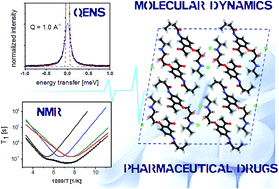On the relaxation dynamics in active pharmaceutical ingredients: solid-state 1H NMR, quasi-elastic neutron scattering and periodic DFT study of acebutolol hydrochloride
Abstract
The molecular dynamics of a cardioselective beta-blocker with intrinsic sympathomimetic activity – acebutolol hydrochloride, was investigated by employing spin-lattice relaxation 1H nuclear magnetic resonance (NMR) and quasielastic neutron scattering (QENS) experiments along with periodic density functional theory (DFT) computations. The relaxation experiments reveal the presence of four dynamic processes, further assigned to the methyl groups reorientations. The analyzed motions were characterized in terms of their activation barriers and correlation times, while their assignment was supported by theoretical computations. The earlier reported crystallographic structure reveals intriguing features in the large-size unit-cell, defined by eight molecular units. By combining solid-state DFT calculations with the intermolecular interactions analysis (Hirshfeld Surface; Reduced Density Gradient), the nature of the stabilizing crystal forces has been revealed, emphasizing the role of moderate-strength (N–H⋯O; O–H⋯Cl; N–H⋯Cl) and weak (C–H⋯O) hydrogen-bond contacts. The theoretical computations provide clear support for the assignment of particular motions and interpretation of the experimental data as showing a competing influence of both internal-structure and intermolecular factors on their activation barriers. The highest energy barriers were assigned to the acetyl-related methyl rotors, the intermediate ones are due to the isopropyl part, while the most-dynamic methyl groups are assigned to the alkyl chain. Inclusion of crystallographic forces via calculations in periodic boundary conditions was found to be essential for a proper understanding of both the conformational and dynamic properties of the system under interest, as it could not be achieved with molecular modeling. Therefore, the performance of several semi-local exchange–correlation functional approximations was critically examined, revealing a clear tendency in favor of the ‘soft’ and dispersion-corrected schemes for estimation of the rotational barriers in pharmaceutical solids.


 Please wait while we load your content...
Please wait while we load your content...